
EX-5100 C
OMBUSTIBLE
ENMET
10
Calibration:
Calibration of Standard Gases:
Calibration of the
EX-5100
should be preformed using the target gas unless Methane is
known to be a possible background hazard. Reference Table 2 Standard Span Gas
The
EX-5100
was factory calibrated using 50% LEL levels of gases. Other levels, minimal 20% LEL, are acceptable. Contact
ENMET
prior to use.
Table 2: EX-5100 Standard Span Gas
Gas
Range
Alarm 1*
Alarm 2*
Alarm 3*
Span Calibration Gas
Calibration Point
Methane
0 – 100 %LEL
10% LEL
20% LEL
50% LEL
50% LEL Methane
50% LEL Methane
Propane
0 – 100 %LEL
10% LEL
20% LEL
50% LEL
50% LEL Propane
50% LEL Propane
Hydrogen
0 – 100 %LEL
10% LEL
20% LEL
50% LEL
50% LEL Hydrogen
50% LEL Hydrogen
Butane
0 – 100 %LEL
10% LEL
20% LEL
50% LEL
50% LEL Butane
50% LEL Butane
*
N
OTE
:
These internal sensor/transmitter alarms are independent of the 4-20mA Controller alarm point settings.
C
AUTION
:
If Methane is a possible hazard, calibration should be done using Methane.
Calibration of Non-Standard Gases:
The
EX-5100
range is 0 – 100% LEL. All Non-Standard gas instruments have been
factory calibrated on LEL of Methane.
Methane is considered to have a coefficient or relative response of 1.00(one). Calibration coefficients relative to Methane have
been generated for over 30 different combustible hydrocarbons and solvents. A partial list of these gases and vapors are listed
in Table 3 Non-Standard Gas. An example of how to use this list of relative response coefficients is shown below.
Example: Acetone coefficient factor is 2.86
20%LEL Methane multiplied by the coefficient of 2.86 = 57
Apply the 20%LEL Methane to the instrument the display should read 57, 57 = 57%LEL Acetone. See Section 5.2.2 Span Gas.
C
AUTION
:
If Methane is a possible hazard, the instrument should be programmed and calibrated for Methane. Calibration
should be done using Methane.
Table 3: Selected EX-5100 Non-Standard Gas
Gas
%LEL
Coefficient
Calibration Gas
%LEL Methane
Display Reads
Acetone
2.6%
2.86
20
57
Isobutane
1.8%
1.82
20
36
n-Butane
1.8%
1.82
20
36
Cyclohexane
1.3%
2.22
20
44
Ethane
3.0%
1.18
40
47
Ethanol
3.3%
2.22
20
44
Ethyl Acetate
2.2%
2.86
20
57
Ethylene
2.7%
1.54
40
62
Hydrogen
4.0%
1.05
50
52
Isopropyl Alcohol (IPA)
2.2%
2.86
20
57
Methanol
6.7%
1.43
40
57
Methyl Ethyl Ketone(MEK)
1.9%
2.86
20
57
n-Pentane
1.4%
2.00
20
40
Propane
2.1%
1.67
40
67
Toluene
1.2%
2.50
20
50
Xylene
1.1%
2.50
20
50
In addition to the established coefficients listed in Table 3 above,
ENMET
can generate calibration data for most common
combustible gases and vapors for which a sample can be readily obtained.




































